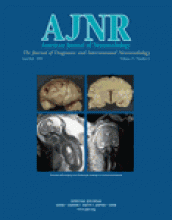In the February issue of the AJNR, two groups described a technique for access to the subarachnoid space with catheters inserted via a simple lumbar puncture (1–3). They used percutaneous intraspinal navigation to produce cerebral vasospasm by placing a microcatheter into the cisterna magna of an animal. They also investigated how a microcatheter can be controllably advanced within the subarachnoid space. Both groups were able to demonstrate that this is an easy and reliable technique to reach almost all regions of the subarachnoid space, and their findings suggested that this methodology has potential for use in humans.
This technique was first described in 1981, when I tested the possibility of catheter navigation within the subarachnoid space (4). Unlike the recently published articles, I used a special needle designed for caudal anesthesia. This needle has a curve at the end that helps with directing the microcatheter cranially or caudally, as desired.
At the time, when MR imaging was not an available technique, it was concluded that catheter navigation offered better diagnostic capability for lesions located in the lateral portion of the spinal canal and provided enhanced analytic capability for dysrhaphic anomalies of the spine and craniocervical junction. The use of the technique today—with better fluoroscopy, microcatheters, and guidewires—is promising with regard to treatment of subarachnoid hemorrhage–induced vasospasm. It also has the potential to serve as a target-specific drug delivery system for anomalies reachable via the subarachnoid space.
- Copyright © American Society of Neuroradiology












